7 Blueprinting Steps… for B2B-Optimized Innovation
Seven steps in the front-end of innovation may seem like a lot… but every Blueprinting step reduces commercial risk in a unique way. By the time your teams present a business case to enter the development stage, there’s very little commercial risk left… just technical risk. For smaller projects you can conduct just the first 3 steps of Blueprinting and present a Market Case.

Step 1. Market research
Our research shows one of the strongest drivers of B2B organic growth is market concentration. This is the strategic selection of a market segment that is winnable and worth winning. Successful companies disproportionately focus resources on understanding and meeting needs in such segments. B2B market segmentation is very different than B2C, and Blueprinting lets you do it quickly and do it right.
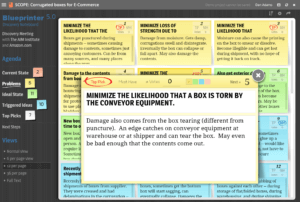
Step 2. Discovery interviews
“Errors of omission” are the failure to uncover customers’ unarticulated needs. They occur all the time, yet no team is ever faulted because needs remain hidden. In qualitative, divergent Discovery interviews, teams digitally project customer comments on Blueprinter® software “sticky notes.” They use strong listening, probing and triggering skills to uncover what competitors miss. Here’s a bonus: Customers love being truly listened to, and become highly engaged in the process.
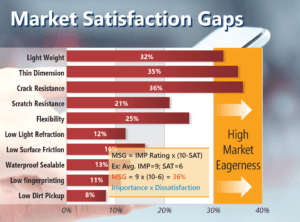
Step 3: Preference interviews
“Errors of commission” occur when you select the wrong customer need(s) to address. Whether caused by weak VOC, confirmation bias, or neglect… our research shows these errors to be rampant. You eliminate such errors in a second round of quantitative, convergent Preference interviews by asking customers for 1-to-10 ratings on importance and current satisfaction for key customer outcomes. You only pursue outcomes that are important and unsatisfied (high Market Satisfaction Gaps). As shown in these dozen-plus Blueprinting case stories, every MSG profile tells a unique story about the needs of a target market.
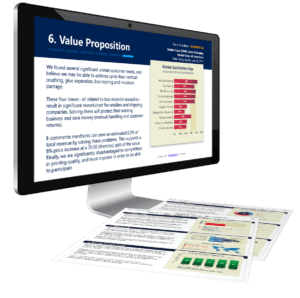
MARKET CASE: Many teams now use our Market Case to enter the development stage… instead of a full Business Case (Step 7 below). The Market Case is often sufficient because it says 1) this is an attractive market segment, both winnable and worth winning… and 2) we understand exactly what customers in this market segment do and do not want. The Market Case contains 6 sections. The last section, Value Proposition, features the Market Satisfaction Gap chart from Preference interviews (Step 3 above). To see how powerful this is, download a Market Case Sample (2-page PDF) or Market Case Sample (6-slide PPT) … both generated by Blueprinter software.

Step 4. Side-by-side testing
Your new product’s price premium is driven by its value over customers’ next best alternative. So if you don’t quantitatively know competitors’ value, you’ll be guessing your new product’s price, right? With Blueprinting’s unique methodology, you ask questions during Preference interviews that later let you replicate the customer experience on your own. Sure, you can still offer prototypes for refinement and engagement… but you’ll know their reaction beforehand.
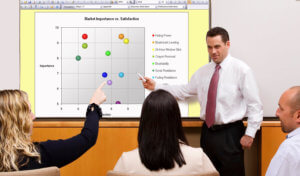
Step 5. Product objectives
At this point, Blueprinting practitioners have an almost unfair advantage over competitors: They have… defined their market segment boundaries (statistically)… understood value chain dynamics… uncovered hidden customer needs… prioritized customer needs without internal bias… and quantitatively assessed next best alternatives. Now they can imagine new product designs and predict the market’s reaction to those designs.

Step 6. Technical brainstorming
Next you move from “customer outcome space” to potential supplier solutions. Sure, you probably conduct brainstorming all the time… but with Blueprinter® software you can replace physical sticky notes with digital sticky notes. This lets you brainstorm with colleagues and experts around the world via web-conference. And Blueprinting includes powerful idea-triggering and converging techniques you won’t find elsewhere.

Step 7. Business case
What if every one of your teams knew how to present a bullet-proof, venture-capital-quality business case? Using Blueprinter® software, they’ll create a 4-page, 12-section business case that covers everything your business needs to know… before entering the costly development stage. They’ll even learn dozens of critical questions for pressure-testing their project well ahead of the next stage-and-gate review.
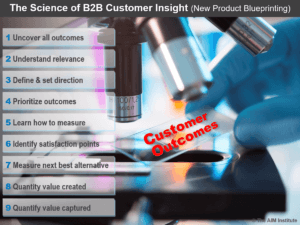
Blueprinting is the “science of B2B customer insight”
The better you understand customer outcomes, the less commercial risk you’ll have. Just as a microbiologist places a specimen under a microscope and turns up the magnification, so Blueprinting examines each outcome in increasing detail. You increase your magnification through 9 levels, until you approach the customer’s level of understanding. When you conduct Blueprinting, you’re practicing the science of B2B customer insight. (See our clients’ case stories for examples.)
Is it hard to learn New Product Blueprinting? Not at all. Check out our 5 Training Plans …with pricing and suggestions on how to get started.
Learn More
Guessing at Customer Needs
Download this white paper and see why 5 out of 6 teams significantly change their product designs… after they conduct Blueprinting interviews.
Reinventing VOC for B2B
Learn the new rules for B2B-optimized voice of customer (VOC) in this e-book by Dan Adams.